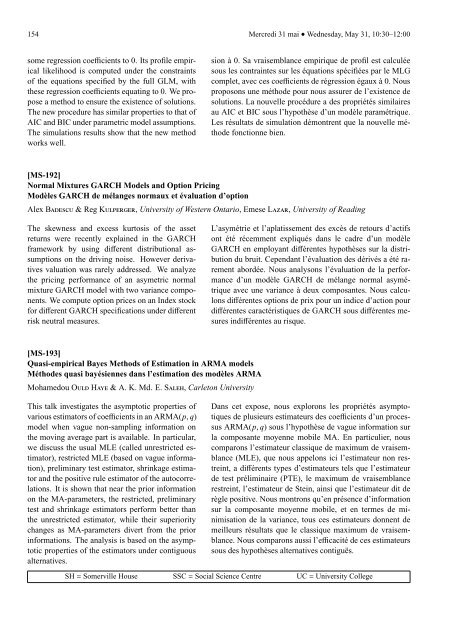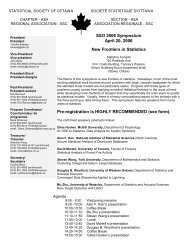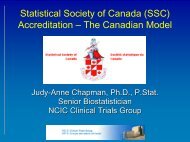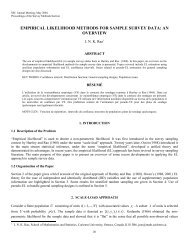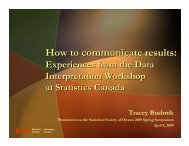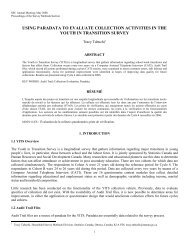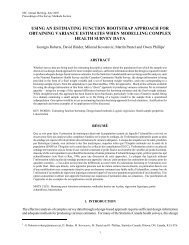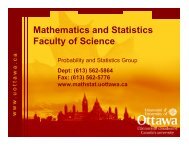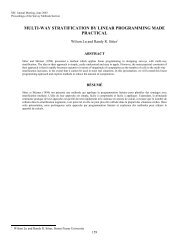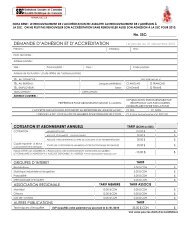Programme et résumés (pdf) - Société statistique du Canada
Programme et résumés (pdf) - Société statistique du Canada
Programme et résumés (pdf) - Société statistique du Canada
You also want an ePaper? Increase the reach of your titles
YUMPU automatically turns print PDFs into web optimized ePapers that Google loves.
154 Mercredi 31 mai • Wednesday, May 31, 10:30–12:00some regression coefficients to 0. Its profile empiricallikelihood is computed under the constraintsof the equations specified by the full GLM, withthese regression coefficients equating to 0. We proposea m<strong>et</strong>hod to ensure the existence of solutions.The new proce<strong>du</strong>re has similar properties to that ofAIC and BIC under param<strong>et</strong>ric model assumptions.The simulations results show that the new m<strong>et</strong>hodworks well.sion à 0. Sa vraisemblance empirique de profil est calculéesous les contraintes sur les équations spécifiées par le MLGcompl<strong>et</strong>, avec ces coefficients de régression égaux à 0. Nousproposons une méthode pour nous assurer de l’existence desolutions. La nouvelle procé<strong>du</strong>re a des propriétés similairesau AIC <strong>et</strong> BIC sous l’hypothèse d’un modèle paramétrique.Les résultats de simulation démontrent que la nouvelle méthodefonctionne bien.[MS-192]Normal Mixtures GARCH Models and Option PricingModèles GARCH de mélanges normaux <strong>et</strong> évaluation d’optionAlex BADESCU & Reg KULPERGER, University of Western Ontario, Emese LAZAR, University of ReadingL’asymétrie <strong>et</strong> l’aplatissement des excès de r<strong>et</strong>ours d’actifsont été récemment expliqués dans le cadre d’un modèleGARCH en employant différentes hypothèses sur la distri-bution <strong>du</strong> bruit. Cependant l’évaluation des dérivés a été ra-rement abordée. Nous analysons l’évaluation de la perfor-mance d’un modèle GARCH de mélange normal asymé-trique avec une variance à deux composantes. Nous calcu-lons différentes options de prix pour un indice d’action pourdifférentes caractéristiques de GARCH sous différentes me-sures indifférentes au risque.The skewness and excess kurtosis of the ass<strong>et</strong>r<strong>et</strong>urns were recently explained in the GARCHframework by using different distributional assumptionson the driving noise. However derivativesvaluation was rarely addressed. We analyz<strong>et</strong>he pricing performance of an asym<strong>et</strong>ric normalmixture GARCH model with two variance components.We compute option prices on an Index stockfor different GARCH specifications under differentrisk neutral measures.[MS-193]Quasi-empirical Bayes M<strong>et</strong>hods of Estimation in ARMA modelsMéthodes quasi bayésiennes dans l’estimation des modèles ARMAMohamedou OULD HAYE & A. K. Md. E. SALEH, Carl<strong>et</strong>on UniversityDans c<strong>et</strong> expose, nous explorons les propriétés asymptotiquesde plusieurs estimateurs des coefficients d’un proces-sus ARMA(p, q) sous l’hypothèse de vague information surla composante moyenne mobile MA. En particulier, nouscomparons l’estimateur classique de maximum de vraisem-blance (MLE), que nous appelons ici l’estimateur non res-treint, a différents types d’estimateurs tels que l’estimateurde test préliminaire (PTE), le maximum de vraisemblancerestreint, l’estimateur de Stein, ainsi que l’estimateur dit derègle positive. Nous montrons qu’en présence d’informationsur la composante moyenne mobile, <strong>et</strong> en termes de mi-nimisation de la variance, tous ces estimateurs donnent demeilleurs résultats que le classique maximum de vraisem-blance. Nous comparons aussi l’efficacité de ces estimateurssous des hypothèses alternatives contiguës.This talk investigates the asymptotic properties ofvarious estimators of coefficients in an ARMA(p, q)model when vague non-sampling information onthe moving average part is available. In particular,we discuss the usual MLE (called unrestricted estimator),restricted MLE (based on vague information),preliminary test estimator, shrinkage estimatorand the positive rule estimator of the autocorrelations.It is shown that near the prior informationon the MA-param<strong>et</strong>ers, the restricted, preliminarytest and shrinkage estimators perform b<strong>et</strong>ter thanthe unrestricted estimator, while their superioritychanges as MA-param<strong>et</strong>ers divert from the priorinformations. The analysis is based on the asymptoticproperties of the estimators under contiguousalternatives.SH = Somerville House SSC = Social Science Centre UC = University College


